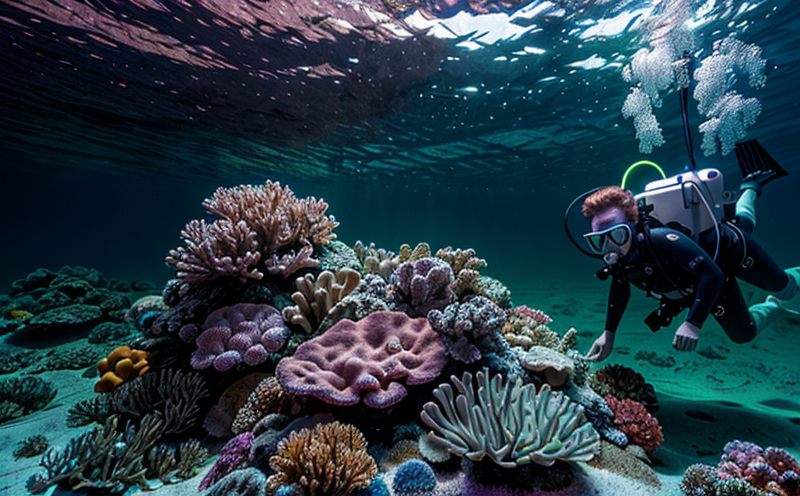IEC 60068 2 52 Cyclic Salt Mist Testing of Underwater Lighting Equipment
The International Electrotechnical Commission (IEC) standard IEC 60068-2-52 defines the cyclic salt mist test method for evaluating the resistance of materials, components, and products to corrosion caused by salt spray or fog. This test is particularly crucial in marine environments where exposure to salt water can significantly impact the performance and longevity of underwater lighting equipment.
Underwater lighting fixtures are subject to harsh environmental conditions such as temperature fluctuations, pressure changes, and constant immersion in seawater. The cyclic salt mist testing ensures that these fixtures maintain their functionality despite prolonged exposure to corrosive environments. This test method simulates real-world marine conditions by exposing the specimens to a series of cycles comprising alternating periods of high humidity and salt spray followed by dry periods.
During the test, specimens are subjected to salt mist for defined durations at specific temperatures and relative humidities. The temperature can vary between 25°C to 40°C depending on the standard requirements. After each cycle, the specimen is dried in a controlled environment before being exposed again. This process continues until the specified number of cycles has been completed.
For marine & underwater lighting equipment, this test ensures that fixtures can withstand corrosive environments without significant degradation in performance or appearance. Compliance with IEC 60068-2-52 is essential for manufacturers aiming to meet regulatory requirements and ensure their products' reliability in challenging conditions.
The cyclic salt mist testing process involves several critical steps:
- Preparation of the specimens
- Setting up the test apparatus according to IEC 60068-2-52 specifications
- Exposure to salt mist for predetermined durations at specified temperatures and humidities
- Drying cycles between each exposure period
- Data collection and analysis
- Evaluation of specimen integrity post-testing
The testing apparatus used in this process must meet stringent requirements outlined by IEC standards. Appropriate fixtures, chambers, and monitoring equipment are necessary to ensure accurate results.
| Parameter | Description |
|---|---|
| Test Temperature Range | 25°C to 40°C |
| Humidity Levels | Absolute humidity at 93% ± 3% |
| Pressure Cycles | Alternating between high pressure and low pressure environments |
| Exposure Duration per Cycle | 10 hours of exposure followed by a drying period |
The results of cyclic salt mist testing are critical for ensuring the reliability and longevity of marine & underwater lighting equipment. Compliance with IEC 60068-2-52 helps manufacturers meet regulatory requirements and ensures that their products perform reliably in challenging environments.
Manufacturers seeking to comply with this standard can benefit from our comprehensive testing services, which include specimen preparation, environmental chamber setup, test execution, data analysis, and reporting. Our experienced team of engineers and technicians ensure that each step adheres strictly to the IEC 60068-2-52 specifications.
Why It Matters
The cyclic salt mist testing method is vital for ensuring the durability and reliability of marine & underwater lighting equipment. Corrosion caused by salt water can lead to significant degradation in performance, reduced lifespan, and increased maintenance costs. By adhering to IEC 60068-2-52 standards, manufacturers can demonstrate their commitment to product quality and customer satisfaction.
Compliance with this standard is particularly important for lighting fixtures that will be used in harsh marine environments where exposure to salt water is inevitable. The test helps identify any weaknesses or vulnerabilities in the design, materials, or manufacturing process early on, allowing for necessary improvements before products reach the market.
The results of cyclic salt mist testing are also valuable for regulatory compliance and certification purposes. Many countries have regulations requiring manufacturers to demonstrate that their products can withstand certain environmental conditions. Compliance with IEC 60068-2-52 provides a robust foundation for meeting these requirements, thereby reducing the risk of non-compliance penalties.
In addition to enhancing product reliability, adherence to this standard can also contribute positively to environmental sustainability efforts. By ensuring that marine & underwater lighting equipment remains functional and efficient over its lifespan, manufacturers help reduce waste and extend resource utilization efficiency. This aligns with broader goals of reducing environmental impact through sustainable design practices.
Industry Applications
- Marine navigation lights
- Underwater searchlights
- Submarine illumination systems
- Oil rig lighting fixtures
- Port and harbor signage
- Research vessel instrumentation
- Offshore oil platform equipment
The cyclic salt mist testing is particularly relevant for these applications due to their constant exposure to seawater, which poses significant risks of corrosion. Ensuring that these lighting systems pass the IEC 60068-2-52 test demonstrates their ability to function reliably even under extreme conditions.
Environmental and Sustainability Contributions
The cyclic salt mist testing method plays a crucial role in promoting environmental sustainability by ensuring that marine & underwater lighting equipment remains functional and efficient over its lifespan. By reducing the need for frequent replacements or repairs, this approach helps minimize waste generation and resource consumption associated with manufacturing new products.
Additionally, compliant manufacturers contribute to sustainable practices by adopting more durable designs and materials that better withstand harsh environmental conditions. This not only extends product lifecycles but also reduces the overall carbon footprint of production processes through decreased frequency of replacements.
Manufacturers who comply with IEC 60068-2-52 standards demonstrate their commitment to both quality assurance and environmental responsibility, which fosters trust among consumers and stakeholders. This aligns with broader trends towards eco-friendly manufacturing and sustainable development goals within the industry.





